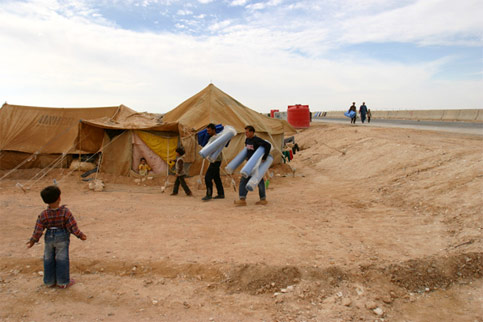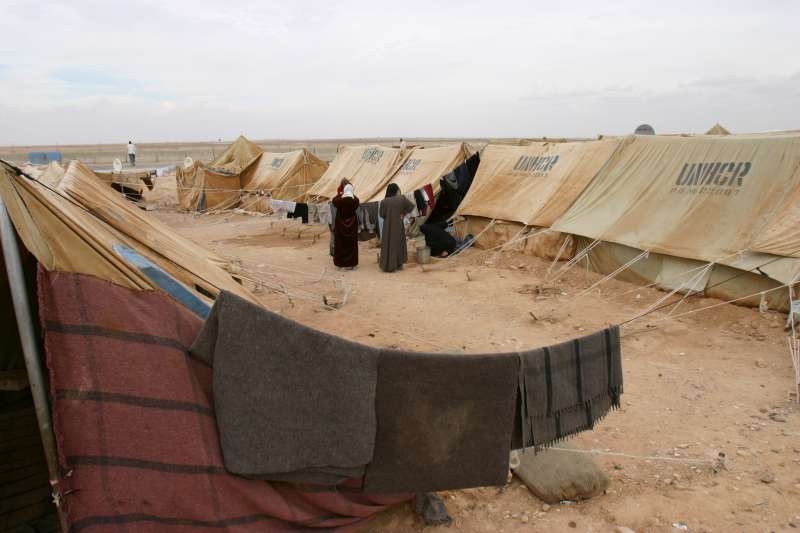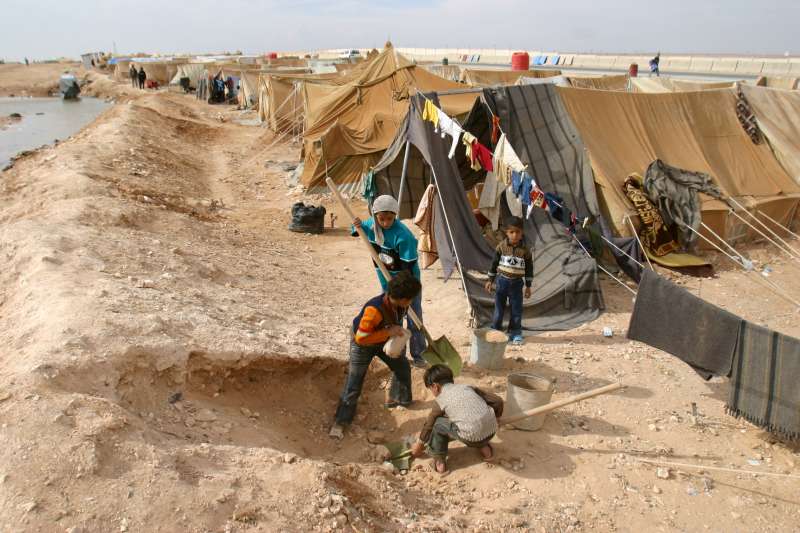In September 2011, the month that Palestinian Authority President, Mahmoud ‘Abbas, submitted Palestine’s statehood bid at the United Nations (UN), Qusai Abdul-Raouf of the Lebanon-based Palestinian Human Rights Foundation was undertaking the task of documenting the increasing number of attacks against Palestinians in the al-Baladiyyat neighbourhood of Baghdad. As he toured the neighborhood, three gunmen—reportedly wearing official Interior Ministry uniforms—abducted him. No one has seen him since.
Palestinians in Iraq had numbered approximately thirty five thousand (although some estimates run as high as ninety thousand) before the 2003 US/UK invasion. According to the UN High Commissioner for Refugees (UNHCR) only thirteen thousand remained in 2009. This figure now stands at approximately seven thousand. The threat to Palestinians in Iraq has grown to the extent that their continued presence in the country is now under serious threat. Palestinian refugees in Iraq are stateless, vulnerable, and forgotten. They are a small segment of the three quarters of the global population of eleven million Palestinians, who are denied their right of return.

The word nakba—literally translated as catastrophe—commonly refers to the ethnic cleansing of Palestinians from their homeland in 1948. But for Palestinians, the nakba never ended, and their dispossession continues. Palestinian refugees are scattered around the world but eighty-eight percent remain close to their land in Israel, Gaza, the West Bank, Jordan, Lebanon, and Syria. Many of them live in abject conditions with little sign of an end to their suffering.
This perpetual crisis—despite its scale and its significant impact on international relations—is heavily marginalized in Western news consumption and parliamentary debate.Central to Palestinian life is the refugees’ right to return to their homes, enshrined in international law and codified in UN resolutions. For Palestinian refugees this right of return is systematically denied, alongside their rights to safety, freedom of movement, work, shelter and food which are routinely violated. The UNHCR has described the plight of the Palestinian refugees more generally as “by far the most protracted and largest of all refugee problems in the world today.” This is the broader context of the Palestinian refugee situation in Iraq.
Nakba Phase One: 1948, 1967, and 1991
Palestinians went to Iraq in several waves, each time fleeing war. The first group was from Haifa and surrounding villages in what is now Israel. This initial group resisted Zionist attacks on their villages during the 1948 War but later fled to Jenin, where the Iraqi army was situated. Under the protection of Iraqi forces, women and children were evacuated to Iraq, and men were incorporated into a special unit of the Iraqi army: the Karmel Brigade. When the Iraqi Army left Palestine in 1949, these villagers (numbering approximately four thousand) retreated with it. After the 1967 war, a second major wave of Palestinians arrived in Iraq. A third influx entered in the aftermath of the 1991 Gulf War—when most Palestinians were expelled from Kuwait and many, particularly those from the Gaza Strip—had nowhere else to go.

Unlike Palestinian refugees in the Occupied Territories of Israel or in Jordan, Syria, and Lebanon, those who lived in Iraq did not fall under the jurisdiction of the UN Relief and Works Agency (UNRWA). Iraq refused UNRWA permission to operate in its territory when it was initially established in the late 1940s. Palestinians in Iraq were issued "special" travel documents, had the right to work, and had full access to healthcare, education, and other governmental services. They also lived in government-owned housing or paid subsidized rent in privately-owned houses. This was certainly better than the appalling living conditions in camps.
But Palestinian refugees in Iraq were not offered citizenship nor were they allowed to own houses or land. Yet they became a source of simmering resentment in the 1980s and 1990s by some Iraqis who believed that Palestinians were getting preferential treatment. This ill feeling further escalated with the Iraqi regime’s policy, particularly after the start of the second intifada in 2000, when money was sent to the families of martyrs in Palestine, despite Iraq’s economic hardship.
Palestinians in Iraq, like the rest of Iraqi society, were then subjected to the most comprehensive sanctions regime in history. Introduced by the UN in August 1990, the sanctions were described by the former UN Humanitarian Coordinator in Iraq, Denis Halliday, in 2000 as “genocide.” They also suffered alongside the Iraqis when the United States continued to bomb the country throughout the period that began at the end of the first Gulf war and continued until the start of the 2003 invasion.
The Ongoing Nakba: 2003
The precariousness of the Palestinian refugees’ situation was exposed after the US-led invasion in 2003. As Iraqi society suffered under the weight of decades of war, sanctions, and their own conditions of internal displacement, resentment at Palestinians’ perceived preferential treatment made them targets for reprisals. The Palestinian community was extremely vulnerable, with no armed group to protect them. And unlike Iraqi citizens, Palestinians bearing Iraqi travel documents were generally unable to seek refuge in neighboring countries. As a result, thousands fled to inhospitable camps in the border areas with Jordan, where they had the choice of remaining under the guarded supervision of Jordanian police officers in fenced-off camps or returning to persecution in Baghdad. Some Palestinians with family connections in Jordan were allowed to enter Jordan, but were barred from working there. The Palestinian Authority repeatedly stated its willingness to accommodate the Palestinians fleeing Iraq in the Gaza Strip but Israel was able to block this due to its control of Gaza’s borders.
In the Al-Hol, Al-Tanf, Al-Ruweished, and Al-Waleed refugee camps in the scorpion-infested desert, refugee health deteriorated due to a lack of access to medical services. José Riera and Andrew Harper of UNHCR reported in 2007: "They have fled death threats and the murder of family members, only to face a deadly environment of searing heat and regular sandstorms." The Palestinians of Iraq had gone full circle, living in tents, just as they did after the ethnic cleansing of 1948.

Syria eventually accepted hundreds of the displaced under the auspices of UNRWA. Jordan accepted a small number able to demonstrate a link to the country, such as through marriage to a Jordanian citizen, but a greater number were only allowed them to stay in the border desert in “internment like conditions.” Many of the families eventually resettled as far away as Brazil, Canada, India, and New Zealand.
The remaining Palestinians live in the At-Tweija, Al-Za’faraniyya, Al-Doura, and Al-Hurriyya neighbourhoods of Baghdad. According to Daleel Al Qassous, the Palestinian Ambassador in Iraq, "They are living in extreme poverty due to high living costs and the lack of work. The UN provides some services to them but their situation is very miserable.”
After the overthrow of the Ba`athist regime, landlords were no longer obliged to grant Palestinians subsidized housing in return for a small government payment as they had been under Saddam Hussein’s rule. These landlords evicted hundreds of Palestinian families. Palestinians in Iraq then had to endure hostile bureaucracy as the Ministry of the Interior chose to treat them as non-resident foreigners rather than as recognized refugees, which was the situation under Saddam Hussein’s regime. As a result Palestinians are required to obtain short-term residency permits of one to two months.
Most Palestinian refugees in Iraq were born in the country and had lived their entire lives there, yet had to regularly apply for residency without guarantee of receiving it. A lack of valid residency documents in today’s Iraq puts refugees at risk of arrest at checkpoints. Since Palestinians’ status has changed after the invasion (requiring them to regularly renew their residency), they have become increasingly vulnerable and subject to both harassment and humiliation.
As the political situation in Iraq deteriorated under occupation, Palestinians have increasingly been harassed and threatened by armed militias who see them as remnants of the Baathist regime. And as the Sunni insurrection grew, sections of the Iraqi media attempted to connect Palestinians to bombings. They were an easy target for those looking for a “foreign” element to blame.
Scores of Palestinians in Iraq have been murdered, tortured, taken as hostages and imprisoned by mainly Shia militant groups. Many were expelled from their homes and initially took shelter in tents in the Haifa stadium in Baghdad. For those remaining in their homes, their situation has become desperately insecure following the spike in Iraqi security forces’ attacks in 2011.
In September 2011, while international attention focused on ‘Abbas’ manoeuvring at the UN, attacks by unknown militants and interior ministry officers against Palestinians increased. The violence was such that many were desperate enough to attempt to flee to an already unsafe country: Syria. In coordination with the United Nations’ refugee agencies the Syrian government agreed to provide temporary shelter to Palestinian refugees at its Al-Hol Camp in early 2010 while the UNHCR worked to arrange more suitable relocations in other countries.
The principal invaders of Iraq—the United States and the United Kingdom—have failed to uphold basic democratic principles and to defend Palestinian refugees. Security for Palestinians in Iraq has been progressively getting worse, even after the installment of a new government, further disclosing the flimsiness of US-UK claims of “democracy promotion” to justify their invasion and subsequent destruction of Iraqi society.
There have been attempts to reduce the refugees` suffering. Various elements of Iraqi society, including religious leaders from Shiite and Sunni communities, have met with Ambassador Al-Qassous to try and find a solution. The leaders trying to find a solution even included Grand Ayatollah Ali Sistani, the highest ranking Shiite religious reference in Iraq.
Yet, despite such goodwill gestures, the fact remains that Palestinian refugees in Iraq are extremely vulnerable. They—like all Palestinian refugees in the diaspora—have no voice in the policies and decisions made by the Palestinian Authority. Palestinian leaders have been more than willing to abandon the right of return, save for a symbolic number. Such weakness will always be taken advantage of by stronger parties looking for political gain. With no voice and no economic power, refugees will not assume their rightful place in the media or on political agendas in the West unless serious steps are taken, from grassroots to government levels, to highlight their plight and comprehend the importance of delivering justice.
In Iraq, like in the Occupied Palestinian Territories, Israel, Jordan, Lebanon, Syria, and the wider diaspora, the nakba is not a historic event; it is a daily, ongoing reality. Since the ethnic cleansing of Palestine in the 1940s, Palestinian refugees have been trapped in a vicious cycle. Violence and intimidation lead to expulsion and temporary resettlement. This is followed by yet more insecurity and more violence with no resolution in sight.
This pattern can only end through the implementation of the Palestinian right of return. Following this logical path would lead to the simultaneous ending of the Zionist dream of a solely Jewish state in historic Palestine. This is an inconvenient reality for many. Yet any attempt to solve the Middle East conflict that does not tackle this reality head on—outlining a clear strategy for the refugees’ enfranchisement and return to their land—is doomed to fail.
[All above photos of Palestinian refugees in tented camps in the Iraqi desert were taken by Thierry Esch of Paris Match.]